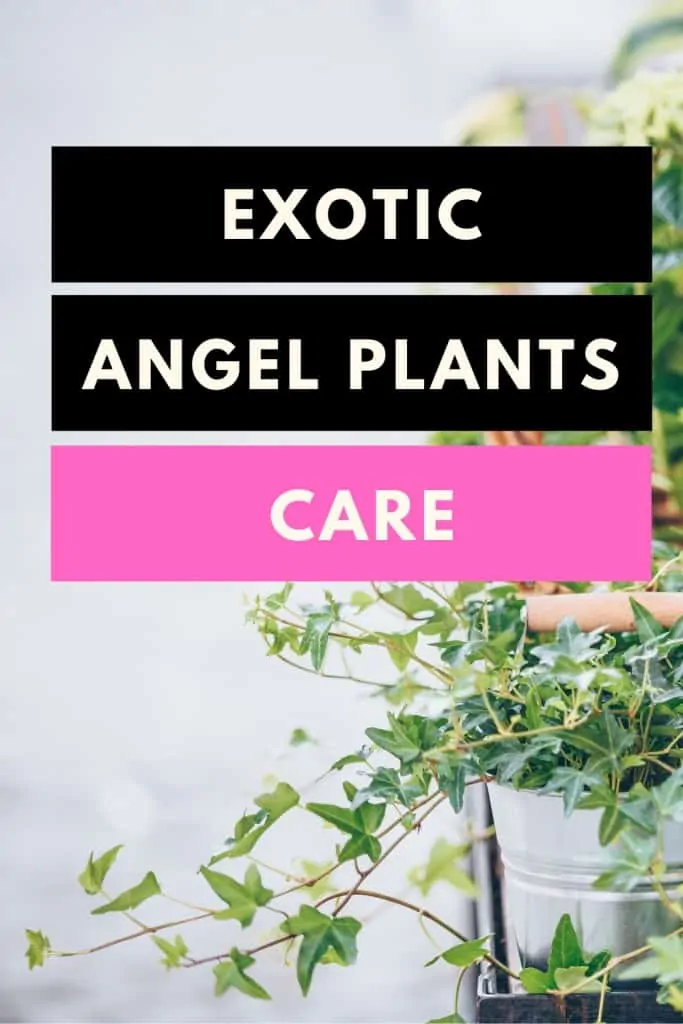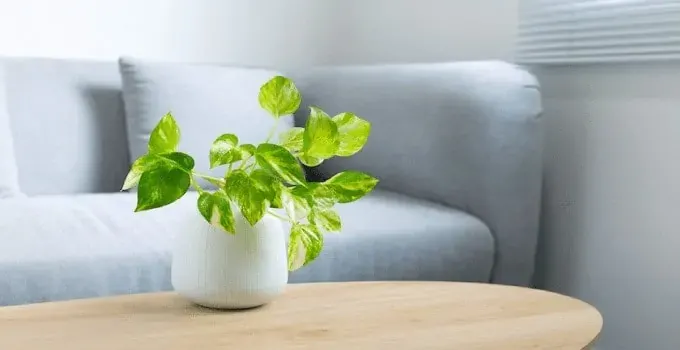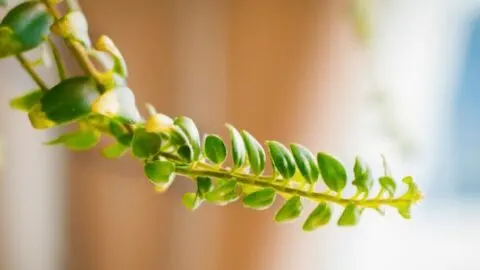They all share tropical origins and are specifically designed to thrive indoors. Many choose an Exotic Angel because it is easy to care for, and aesthetically pleasing.
There is no question that keeping an Exotic Angel plant indoors is relatively straightforward. They can be kept in pots or hung as a cascading individual.
Regardless of which option you choose, we have provided a thorough guide on how to keep them happy and long-lasting.

Exotic Angel Plants
Table of Contents
EXOTIC ANGEL PLANT CARE BASICS
Even if a plant is biologically altered to be an indoor candidate, it is the owner’s job to make sure that all needs are met.
These basic requirements include the amount of light that they should be exposed to, water saturation, pruning, and much more.
Since Exotic Plants are a brand rather than a particular species, we’ve done our best to include the most concise instruction manual.
SOIL
Looking at the families included in this brand, the majority of them require the soil to at least be moist without overly saturated. These plants have been known to develop root rot if they sit in water for too long.
The best soil options should be well-draining, peat moss based, and relatively rich in organic material. If you’re concerned about the soil not being accurate, we recommend looking up the particular species that you own.
LIGHT
The general preference for Exotic Angel plants is indirect sunlight. These flowering individuals can be subjective to burn damage when placed in the sun for too long. However, don’t let this trick you.
They do need sunlight to grow those vibrant flowers. Some Exotic Angel variations even want direct exposure, but partial sunlight tends to be the best compromise as a whole for the group.
WATERING
Exotic Angels, regardless of which species you own, do best when given moderate levels of water. This tends to change depending on several variables. Plants that are first watered require more water than adults, about two or three times per week.
Once an Exotic Angel has started to mature, they generally need weekly watering sessions. If it’s warm where you live, consider checking the soil for dryness. We will take a closer look at watering later on in the article.
TEMPERATURE
As far as temperature goes, you’ll want to keep it somewhere around 16 to 21 degrees Celsius, which is rather easy to do indoors. Their biggest problem tends to happen when the room temp suddenly drops or experiences a sudden draft.
Anything lower than 10 degrees Celsius will result in the yellowing of leaves. Another thing to watch out for is extreme heat or if the air becomes too dry. This can also have negative impacts on your flora.
HUMIDITY
Given their tropical origins, it’s no surprise that Exotic Angel plants enjoy living in a household that has ample humidity. The typical indoor humidity is around fifty percent.
This tends to be an ideal level for most Exotic Angel plants. Some varieties do require more, so be sure to keep a close eye on the leaves. If you notice that they have started to dry out, then you may not want to start adding more moisture.
This can be easily fixed with the misting from a spray bottle.
FERTILIZER
Adding fertilizer can be a tricky feat. Certain plants don’t require the boost while others need it to grow vibrant flowers. For the most part, Exotic Angel plants don’t necessarily demand it, but they can be low in Nitrogen, Phosphorus, and Potassium.
Adding a water-soluble fertilizer once a month can be advantageous. Just be sure to implement this feeding regimen directly after watering and don’t start unless you see active growth.
Some species, such as the Dragon plant, are pickier about their fertilizers so do your research first.
Still confused about the balance of elements found in soil, consider reading our article on NPK Fertilization.
PROPAGATION
There are several ways that you can propagate an Exotic Angel plant, though the two most common techniques tend to involve stem cuttings and propagating the individual in water.
Of course, we highly recommend that you study the proper propagation methods for your Exotic Plant species.
Growing a new plant from the parent individual can be somewhat tricky, depending on the amount of knowledge and previous experience that you bring to the table.
GROWTH
As a whole, the Exotic Angel brand is known for being relatively small, making them an ideal flora for most indoor plant enthusiasts.
Not all of them are as petite, the largest individuals including Snake plants and Pothos.
These species tend to grow up to 8 inches tall, which can be considered on the larger end for houseplants. Fortunately, you can decide on a smaller plant if that’s what you need.
POTTING
The typical method for a flora that needs to be transferred to a larger pot is quicker than what an Exotic Angel plant needs. These are more delicate houseplants, requiring a gradual transition.
If you notice that the roots and leaves are starting to become crowded, set up a new pot that is only a few more inches wider.
Give your Exotic Angel time to adjust before transferring it once again to a new pot, with the same principles. By doing this, you’re allowing the houseplant to regulate itself, preventing overall shock.
THE PRACTICE OF WATERING YOUR EXOTIC ANGEL
I’m sure that you’ve wished that the whole process of watering your flora could be simpler. Well, we’ve tried to pinpoint the special requests needed for a healthy Exotic Angel plant.
Too much water can wreak havoc on your houseplant. Taking out the guesswork can make watering your Exotic Angel much simpler and less stressful
GENERAL WATERING ROUTINES
We understand that it might be difficult to generalize what your Exotic Angel plant needs in terms of a consistent schedule. There are a few outliers that have different requests, but we’ve been able to identify a typical routine that you can follow.
As we had mentioned earlier in this article, it is usually best to water an Exotic Angel about once per week. Younger individuals should be given more moisture with about two to three watering sessions weekly.
After about twenty days or so, you can continue with a routine schedule that will keep the soil moist. Certain seasons require you to modify this routine.
For the growing seasons, namely summer and spring, expect to add enough water that the water will drain out of the holes on the bottom of your pot. Restrict yourself from giving too much water during the winter months.
Another thing to note is that any water that you do add should be lukewarm. Cold liquid can actually shock the roots.
LOOK FOR THE SIGNS
There are a few ways that can help indicate whether your Exotic Angel needs you to lay off the watering can, or to add more moisture.
Certain species have specific telltale signs to look for, so it’s important to understand what your plant is telling you.
Plants are generally pretty decent at telling their owners when something is wrong.
But, it helps to know the signs. Some floras, such as the Laceleaf, tend to shed their blossoms when the soil is too dry.
You can also check the plant yourself.
All you need to do is put your finger into the soil. If the top few inches under the surface are dry, then this means that more moisture should be added.

As we have seen earlier in this article, Exotic Angel Plants are actually a brand rather than one single plant species. There are over 400 varieties of Exotic Angel plants. The Brand Exotic Angel plants was created and owned by Hermann Engelmann Greenhouses. They have later been acquired by Costa Farms. Costa Farms sells this plant brand through retailers. In this picture, you see a pothos plant. Pothos is one of the plant varieties that is also sold under the brand “Exotic Angel Plants.”
CAREFULLY PROPAGATING AN EXOTIC ANGEL
With such a large variety, the propagation methods vary greatly for Exotic Angels, as a whole. To make it easier, we’ve chosen to focus on a fairly common member of the brand, the Purple Passion Plant, or Gynura.
Although you can choose to propagate through seed germination or in water, stem cuttings are the easiest.
PROPAGATION THROUGH STEM CUTTINGS
- Start by getting a pot ready. It should contain a mixture of peat moss and perlite for the best results. Thoroughly saturate the soil before propagation.
- With sharp, properly cleaned scissors or shears make three to four-inch stem cuttings, making sure that there is at least one node on these segments.
- Take the cuttings and place them into the soil, open-faced.
- Choose a spot in the house with ample sunshine and warm temperatures. The humidity should be relatively high as well.
- Continue to water your stem cuttings two or three times a week, but allow the moisture to drain out the bottom with ample holes.
- You should start to see roots in a few weeks, which is when you’ll need to carefully transfer your stem cuttings to new pots.
EXOTIC ANGEL PEST COMPLICATIONS
It’s unfortunate, but plants can be susceptible to several pests. Indoor flora tends to be at a slightly decreased risk, but it still can happen. The most common pests include scale insects, spider mites, aphids, mealybugs, and thrips.
Most of these enemies have a knack for attacking the leaves or stems of your Exotic Angel, thus even potentially stopping growth altogether.
Signs that your Exotic Angel has been infected with any of these pests can be the presence of webs, dots on the foliage, or a sticky residue.
Most miticides, insecticides, and tactics of spraying your plant down with water should work, but it’s best to do your research first.
TELLTALE SIGNS THAT YOUR EXOTIC ANGEL IS UNHAPPY
Here are two of the most common problems that you may face with an Exotic Angel plant, and how to go about fixing them before it becomes irrevocable.
TELLTALE SIGN #1: WILTING
Cause: The wilting of a flowering plant is generally an indication of watering issues. It can either mean too much, or too little.
Remedy: You’ll want to test which problem you’re experiencing. It may be easier to scale back on your watering sessions and then see if the Exotic Angel starts to come back. If it doesn’t, slowly add more moisture.
TELLTALE SIGN #2: YELLOW SPOTS ON LEAVES
Cause: Spots that start to develop on the underside of an Exotic Angel’s leaves tend to be due to a pest problem, namely spider mites.
Remedy: Fixing spider mite infestations generally are solved through the use of either oil called Neem or spraying it down with water. Taking a hose and spraying the plant can be enough for smaller cases.
FIVE STEPS TO A HEALTHY EXOTIC ANGEL PLANT
We understand that there might be a lot of information packed into one article. To help you out, we’ve decided to compile the top five points in allowing your flora to thrive.
- Placement! Choose a spot in your home that gets plenty of partial sunlight.
- Be sure that your Exotic Angel receives lots of warmth and humidity, adding a misting regime if need be.
- Implement a weekly watering schedule, unless your plant tells you differently.
- Be careful when choosing to add fertilizer, only doing that about once a month.
- Keep a close eye on the leaves to watch for pests!
EXOTIC ANGEL PLANT FAQ
Are Exotic Angel plants poisonous?
You may be shocked to find that almost every single part of your Exotic Angel plant is poisonous for you, your family, and your pets. This includes the leaves, seeds, and roots. They would need to ingest these plant parts to get sick.
Why is my Exotic Angel plant dying?
There are several reasons as to why your plant might be dying. The more common reasons tend to be either overwatering, sudden drops in temperature or a lack of humidity.
Where did Exotic Angel plants get their name?
Oddly enough, these plants got their name from a company called the Hermann Engelmann Greenhouses Incorporation. There are over 400 species, all of which range in color, yet they all share their ability to be raised indoors.

Daniel has been a plant enthusiast for over 20 years. He owns hundreds of houseplants and prepares for the chili growing seasons yearly with great anticipation. His favorite plants are plant species in the Araceae family, such as Monstera, Philodendron, and Anthurium. He also loves gardening and is growing hot peppers, tomatoes, and many more vegetables.


